Enable USB Debugging on Locked Phone (Full Guide)
Enabling USB debugging when the phone is locked is a challenge for many Android users, but it is essential for recovering data or performing advanced operations. This article details how to enable USB debugging when the phone is locked.
Android Unlock Tips
Android Pattern Unlock
Android Fingerprint Unlock
Android Factory Reset
- Factory Reset Samsung Galaxy S8 without Password
- Factory Reset Samsung Galaxy S9 without Password
- Factory Reset Samsung S10 without Password
- Factory Reset Samsung A10 without password
- Factory Reset Samsung J7 without password
- Factory Reset ZTE without Password
- Factory Reset Huawei When Locked
- Factory Reset LG Phone without Password
Have you ever encountered such a dilemma: you need to enable USB debugging on a locked phone, but find that you can’t bypass the lock screen password? According to the latest research, more than 30% of smartphone users have experienced forgetting the lock screen password in their daily lives.
How to enable USB debugging in this situation has become an urgent need for many users. Whether it is because the phone is accidentally damaged and needs data recovery, or because you can’t unlock it because you forgot the password, it is crucial to find a quick and effective solution. This article discusses in detail how to enable USB debugging on a locked phone to help you easily solve this problem.
What Can you Do with USB Debugging?
In essence, USB debugging is a process where an Android phone is connected to a PC so that the owner or developer can control it externally. This is accomplished through the Android SDK which needs to be installed on the PC, with a USB port serving to establish the connection.
When USB debugging is enabled on the phone, all information that is stored on the phone including log files, contacts, or personal documents can be accessed from a computer.
And, USB debugging is commonly used to root the device or create a debugging bridge, so there are many practical applications for it.
However, having this feature enabled could also represent a security flaw if the phone ends up in the hands of a malicious person. This is why the decision whether to allow USB debugging should be made only after carefully analyzing your realistic needs and security threats.
How to Enable USB Debugging on a Locked Phone?
When dealing with an Android device, enabling USB debugging is one of the key steps to perform advanced operations, data recovery, or troubleshoot problems.
However, this process becomes complicated when your device is locked. The following article will detail how to enable USB debugging on a locked phone, including methods such as using ADB commands, recovery mode, and professional tools. These steps will help you effectively enable USB debugging on the locked screen, allowing you to continue with necessary operations and management.
Continue to learn how to enable USB debugging on a locked Android device.
Method 1. Enable USB Debugging on Android Phone through “Forgot Password”
Step 1. Unlock your Phone
Perhaps the easiest way to get around the lock is to use the Forgot password feature, which can be activated in the following way:
- Try entering an incorrect password into the lock screen several times.
- When Forgot password button appears, tap on it.
- Use Google credentials associated with the phone to log in.
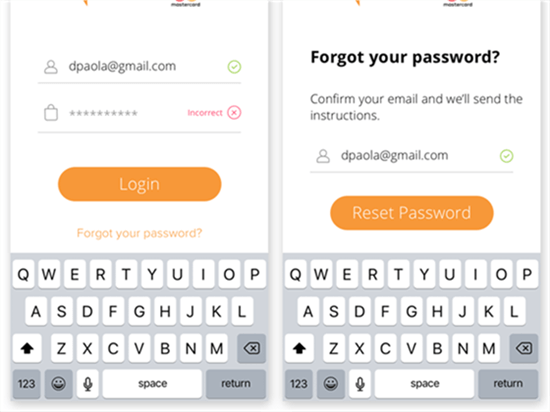
Unlock your Phone
Alternatively, you could download specialized software that can unlock your phone. There are multiple products that match this description, including DroidKit by iMobie which has been proven very effective in this role. It allows you to remove any phone screen locks, even you got Goole locked on Samsung. However, some of those methods might delete personal data kept on the device.
Step 2. Turn on Enable USB Debugging on Android
Once you gain access to the phone and enter the main menu, you need to manually check the option to enable USB debugging. Here is how to do it;
- Open the Settings menu on your phone.
- Navigate through the menu by choosing System, then Advanced, and then Developer Mode.
- In Developer Mode, toggle the slider next to the USB debugging option.
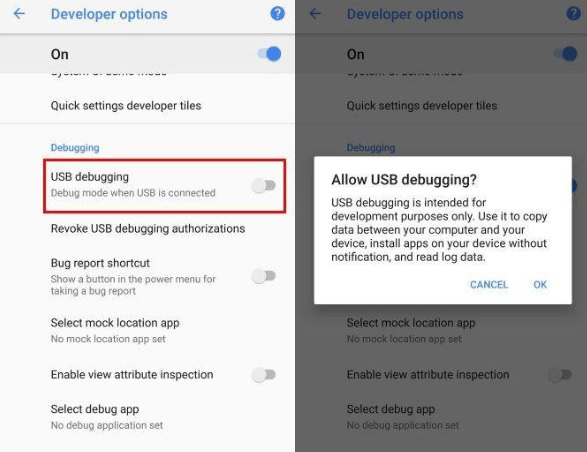
Turn on USB Debugging
Method 2. Use ADB Command to Enable USB Debugging on Android Phone
To enable USB debugging on an Android phone using ADB (Android Debug Bridge) commands, follow these steps:
Prerequisites:
- Install ADB on your computer:
- Ensure that ADB is installed on your computer. You can download the Android SDK Platform Tools from the official Android developer website.
- Enable Developer Options on your Android phone:
- Go to your Android phone’s Settings.
- Scroll down to find “About phone” or “About device”.
- Tap on the “Build number” 7 times in quick succession. You will see a message saying “You are now a developer!” This action enables Developer Options on your phone.
Steps to Enable USB Debugging using ADB:
1. Connect your Android phone to your computer:
Use a USB cable to connect your Android phone to your computer.
2. Open a command prompt or terminal window on your computer.
3. Verify ADB recognizes your device:
Type the following command and press Enter: adb devices
This command lists the devices connected to your computer. If your device is recognized, you will see its serial number in the list. If it prompts for authorization on your phone, allow it.
4. Enable USB debugging:
Once your device is recognized, execute the following command: adb shell settings put global development_settings_enabled 1 / adb shell settings put secure usb_debugging_enabled 1
These commands enable USB debugging on your Android phone.
5. Verify USB debugging is enabled:
You can verify if USB debugging is enabled by checking the Developer Options on your phone:
- Go to Settings > System > Developer options (the location may vary depending on your device).
- Look for “USB debugging” and ensure it is turned on.
Additional Tips:
- Disabling USB Debugging: If needed, you can disable USB debugging using ADB by setting
usb_debugging_enabledto0using the same commands. - Handling Permissions: Depending on your Android version and manufacturer, you may need to authorize USB debugging on your phone when prompted.
By following these steps, you can use ADB commands to enable USB debugging on your Android phone.
Method 3. Enable USB Debugging on Your Phone Using Recovery Mode
Enabling USB debugging on your phone using recovery mode is typically used when you cannot access the Android operating system due to issues like a forgotten password or a malfunctioning system. Here’s how you can enable USB debugging via recovery mode:
How to Enable USB Debugging Using Recovery Mode:
1. Boot into Recovery Mode:
Power off your Android phone completely.
Depending on your device, you’ll typically need to press and hold a specific combination of hardware buttons simultaneously to enter recovery mode. Common combinations include:
- Volume Up + Power button
- Volume Down + Power button
- Volume Up + Volume Down + Power button
Continue holding the buttons until you see the recovery mode screen.
2. Navigate in Recovery Mode:
Use the volume buttons to navigate through the options in recovery mode.
Locate and select the option that says “Apply update from ADB” or similar. This option allows you to apply updates and execute ADB commands from your computer.
3. Connect Your Phone to Your Computer:
Use a USB cable to connect your phone to your computer.
4. Open Command Prompt or Terminal on Your Computer:
On your computer, open a command prompt (Windows) or terminal (Mac/Linux).
5. Verify ADB Recognizes Your Device:
- Type the following command and press Enter: adb devices
This command lists the devices connected to your computer. If your device is recognized, you will see its serial number in the list. If it prompts for authorization on your phone, allow it.
6. Enable USB Debugging:
- Execute the following command to enable USB debugging on your phone via ADB: adb shell service call activity 42 s16 com.android.settings/.Settings\$DevelopmentSettingsActivity
This command directly launches the Development Settings activity where you can enable USB debugging.
7. Navigate to USB Debugging Option:
- On your phone, navigate through the recovery mode menu to locate the “USB debugging” option under Developer Options or a similar section.
- Enable USB debugging.
8. Exit Recovery Mode:
Once USB debugging is enabled, use the recovery mode menu to reboot your device normally.
Method 4. Enable USB Debugging Using iMobie DroidKit
Bypassing the lock screen on Android using Android Unlock Tool is the best way to enable USB debugging on Android from computer.
iMobie DroidKit is a tool dedicated to Android devices. Including removing lock screen, bypassing FRP lock, recovering lost data, fixing system problems, etc.
Free Download * 100% Clean & Safe
Step 1. Free download iMobie DroidKit and launch it > Click Unlock Screen.

Choose Screen Unlocker
Step 2. Connect your Samsung and Start. Note: All content on your device will be erased after the screen lock gets removed successfully.
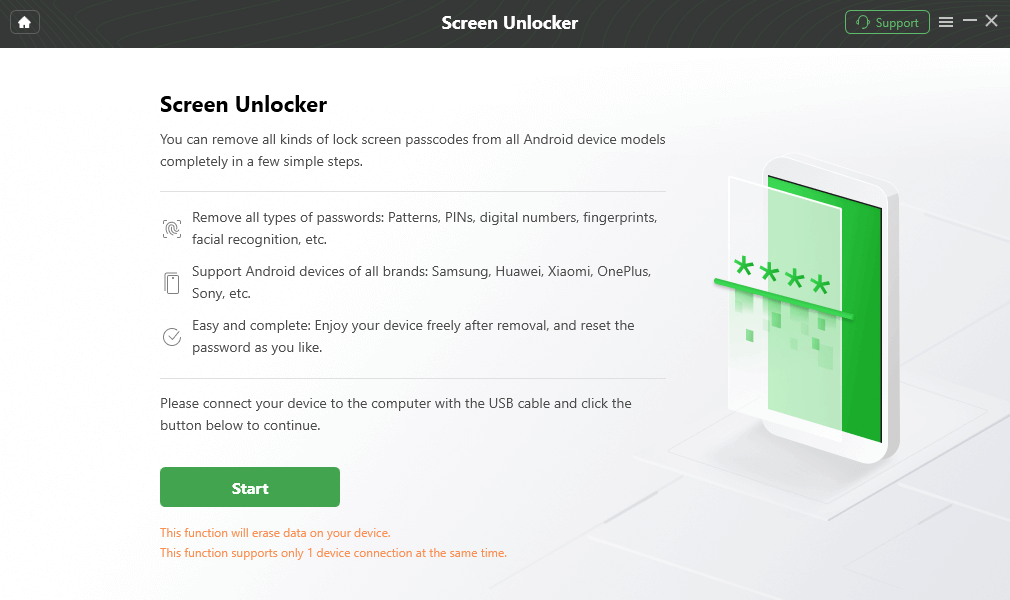
Connect your Locked Phone
Step 3. When the configuration file is prepared, click Remove Now.
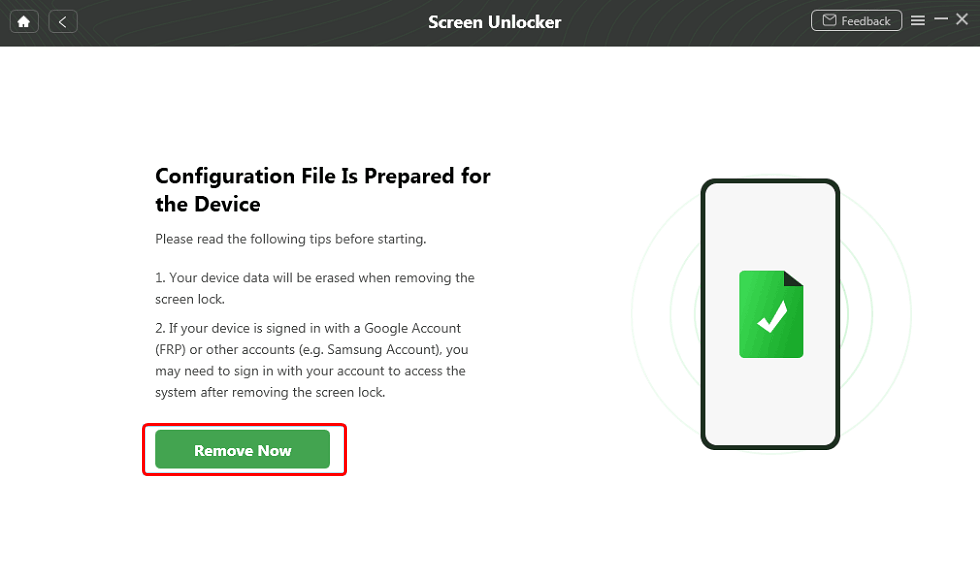
Click Remove Now Button
Step 4. Select your Device brand and Next. Follow the on-screen instruction to remove the screen password.
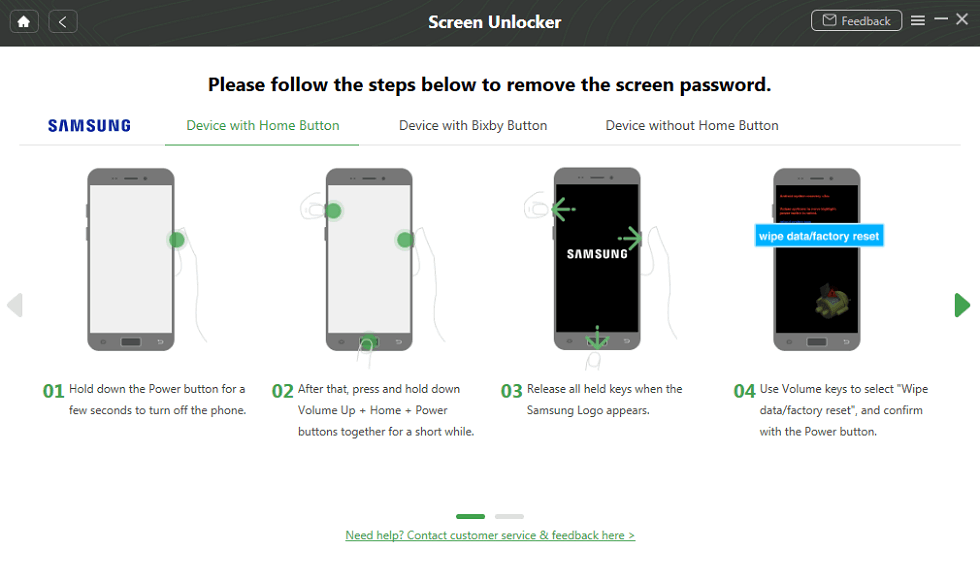
Confirm Locked Device Brand and Continue
Step 5. Wait for Screen Lock Removal Completed as below.
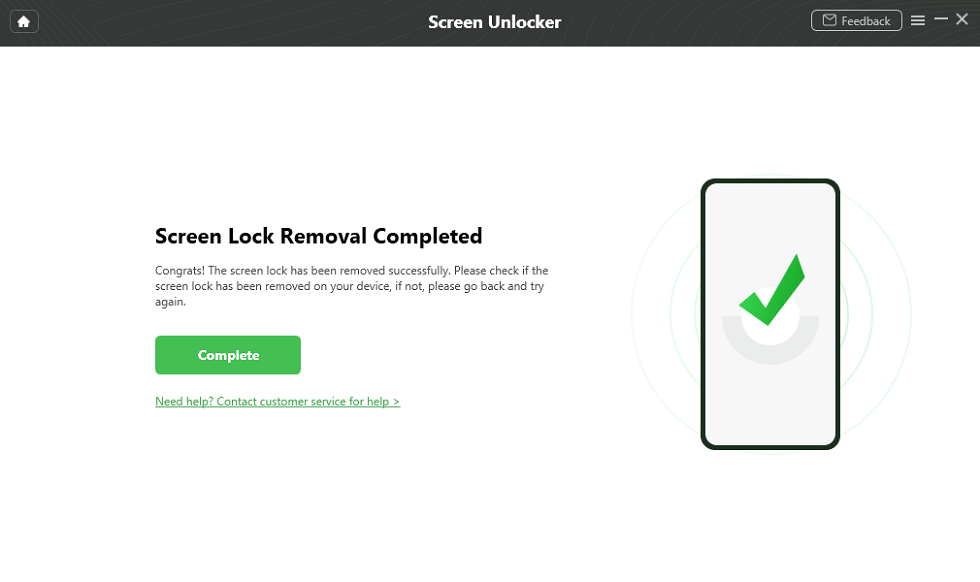
Lock Screen Removal Completed
Method 5. Use Android SDK Tools to Enable USB Debugging
Using Android SDK Tools to enable USB debugging is a straightforward process if you have the Android SDK Platform Tools installed on your computer. Here’s a step-by-step guide on how to do it:
Prerequisites:
1. Install Android SDK Platform Tools:
Download and install the Android SDK Platform Tools from the official Android developer website.
2. Enable Developer Options on Your Android Phone:
- Go to your Android phone’s Settings.
- Scroll down to find “About phone” or “About device”.
- Tap on the “Build number” 7 times in quick succession. You will see a message saying “You are now a developer!” This action enables Developer Options on your phone.
How to Enable USB Debugging Using Android SDK Tools:
1. Connect Your Android Phone to Your Computer:
Use a USB cable to connect your Android phone to your computer.
2. Open Command Prompt or Terminal:
On your computer, open a command prompt (Windows) or terminal (Mac/Linux).
3. Navigate to Android SDK Platform Tools Directory:
Change directory to where you installed Android SDK Platform Tools. For example:
- cd C:\path\to\android-sdk\platform-tools (Windows)
- cd /path/to/android-sdk/platform-tools (Mac/Linux)
4. Verify ADB Recognizes Your Device:
Type the following command and press Enter:
- adb devices
This command lists the devices connected to your computer. If your device is recognized, you will see its serial number in the list. If it prompts for authorization on your phone, allow it.
5. Enable USB Debugging:
Execute the following command to enable USB debugging on your Android phone:
- adb shell settings put global development_settings_enabled 1
- adb shell settings put secure usb_debugging_enabled 1
These commands enable USB debugging on your Android phone.
6. Verify USB Debugging is Enabled:
You can verify if USB debugging is enabled by checking the Developer Options on your phone:
- Go to Settings > System > Developer options (the location may vary depending on your device).
- Look for “USB debugging” and ensure it is turned on.
How to Enable USB Debugging when the Phone is Broken?
If the phone is physically damaged and unresponsive and USB debugging hasn’t been turned on beforehand, using USB OTG and a mouse to enable USB debugging is a very practical method.
In this case, since it is impossible to operate by touching the screen, USB OTG and a mouse can be used as an alternative to control the device and make necessary settings.
How to enable USB debugging on Android using USB OTG and a mouse:
Step 1: Preparation
Make sure your Android device supports the USB OTG function and prepare a USB OTG adapter.
Step 2: Connect a USB mouse
Connect the USB mouse to the Micro USB or USB Type-C port of the Android device using a USB OTG adapter.
Step 3: Operate the mouse
Operate on the device with the connected USB mouse. You can simulate touch operations by clicking, as well as scroll and navigate.
Step 4: Enable developer options
- In the device’s Settings application, find and open “About phone”.
- Find “Build number” and tap it 7 times in a row until it shows that the developer options are enabled.
Step 5: Enable USB debugging
- Return to “Settings” > “System” > “Developer options”.
- Enable “USB debugging”.
Step 6: Confirm the connection
Connect the device to the computer and make sure ADB can recognize and connect to the device. You can use the ADB command line tool on your computer to perform related operations.
The Bottom Line
Enabling USB debugging on a locked phone is a critical operation, especially for developers and technology enthusiasts. Although there are multiple ways to enable USB debugging on a locked phone, some methods may require more complicated steps or professional technical knowledge.
In this case, iMobie DroidKit, as a simple and efficient tool, can help users easily unlock their phones, bypass lock screen restrictions, and quickly enable USB debugging, so that users can more conveniently perform operations such as data transfer and application debugging.
Free Download * 100% Clean & Safe
Product-related questions? Contact Our Support Team to Get Quick Solution >

